Low calorie nourish bowls are a delicious and filling vegan meal packed with lean protein and non-starchy veggies. These nourishing bowls of healthy goodness incorporate kale, roasted Brussels sprouts, sweet potatoes, peppers, and roasted chickpeas. Then everything is drizzled with our nourish bowl dressing, a creamy tahini sauce, to make a hearty and satisfying vegetarian meal prep. Get tips on making these under 500 calorie power bowls low carb and gluten free as well!
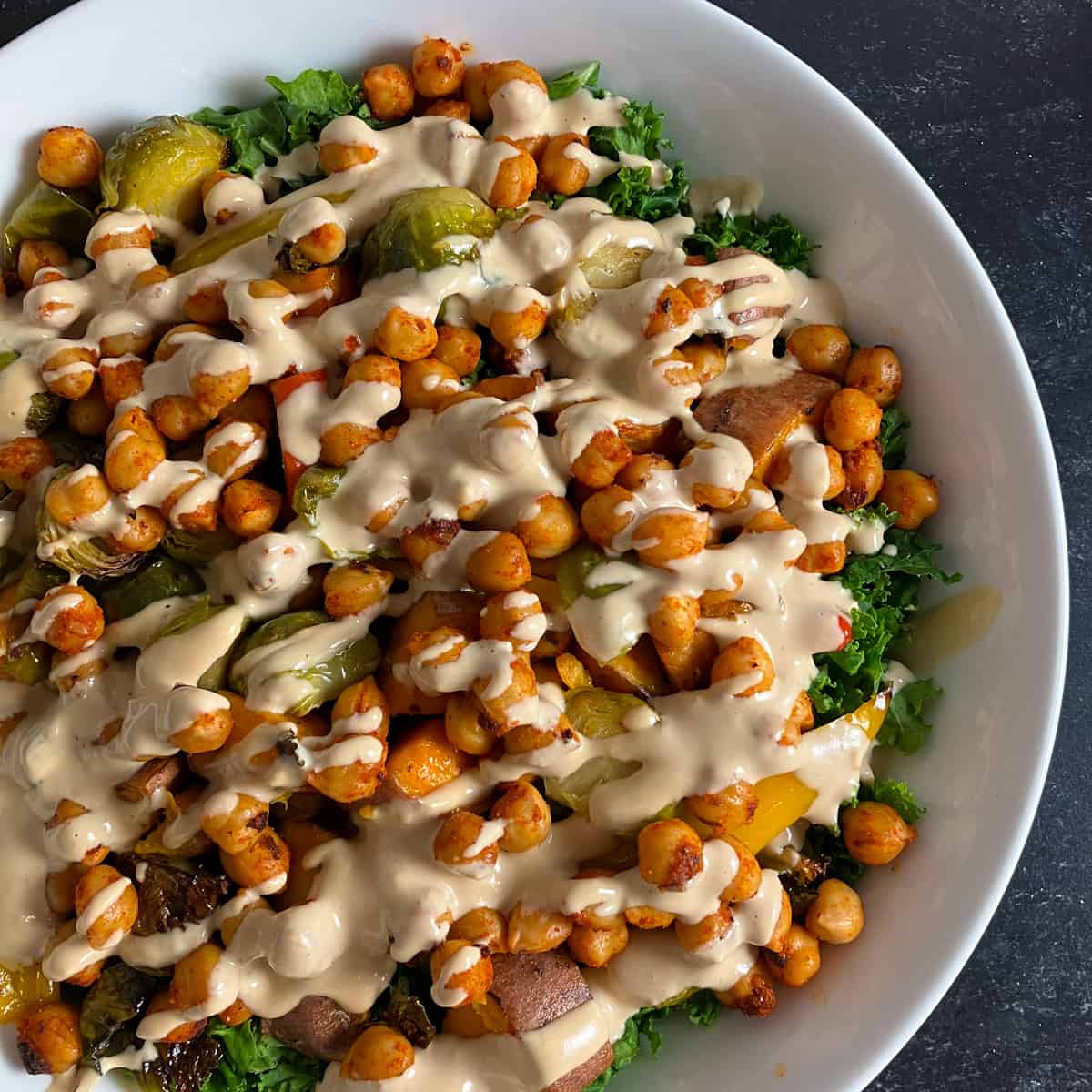
Want to save this post?
Enter your email below and we'll send it straight to your inbox. Plus you'll get great new recipes from us every week!
Table of Contents
🥗 Low Calorie Nourish Bowls
Nourish bowls are a flexible recipe like the meal planning based on MyPlate formula. Here’s the basic formula for building a nourish bowl:
- Vegetables: To make four bowls, I roasted two sweet potatoes, 1 lb Brussels sprouts, one red bell pepper, and one yellow pepper in 1 tablespoon of olive oil. For low carb vegan nourish bowl, swap out the sweet potatoes for cauliflower or broccoli and do chicken instead of chickpeas.
- Protein: No nourish bowl is complete without protein! I heated two cans of drained chickpeas on the stovetop with 2 teaspoons of smoked paprika and ½ teaspoon each onion powder and garlic powder. You could also use sliced, grilled chicken breast, thin strips of grilled steak, air fryer tofu, smoked tofu, edamame, tempeh, or your favorite high protein food.
- Healthy fats: Healthy fats are coming at you from multiple sources in this recipe. We’re roasting the vegetables in oil, plus we’ve got the tahini dressing rich in sesame seeds.
- Vegan Nourish Bowl Base: Whole grains are optional in these bowls, since there are plenty of healthy carbs in the sweet potatoes and chickpeas. Instead of the quinoa, brown rice, wild rice, or whole wheat pasta, I used a base of 10 ounces of massaged kale to keep things low calorie. Other options include cauliflower rice, lettuce, spinach, zoodles, or butternut squash noodles.
- Toppings for texture and crunch: Add pomegranate arils, nuts, chia seeds, pumpkin seeds, sunflower seeds, nutritional yeast, cheese, or your favorite seasonings and spices for more flavor. (Don’t forget this will change the nutrition info for the recipe.)
- Anything else you'd like! Did I forget anything? Hummus? Kimchi? Parsley, cilantro, or basil? Fermented red cabbage sauerkraut? Go for it!
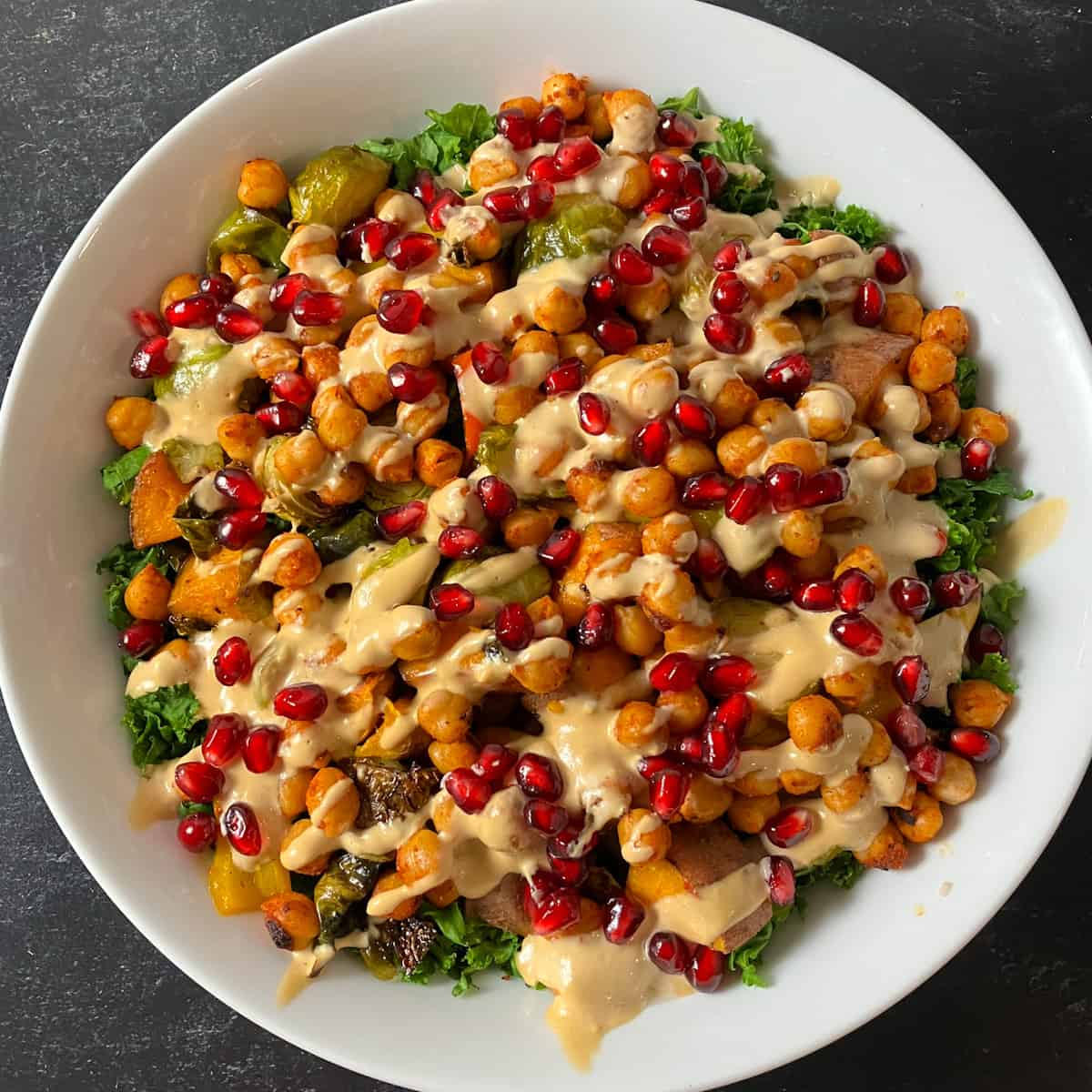
Get a printable recipe card with specific ingredients for this recipe at the end of the post!
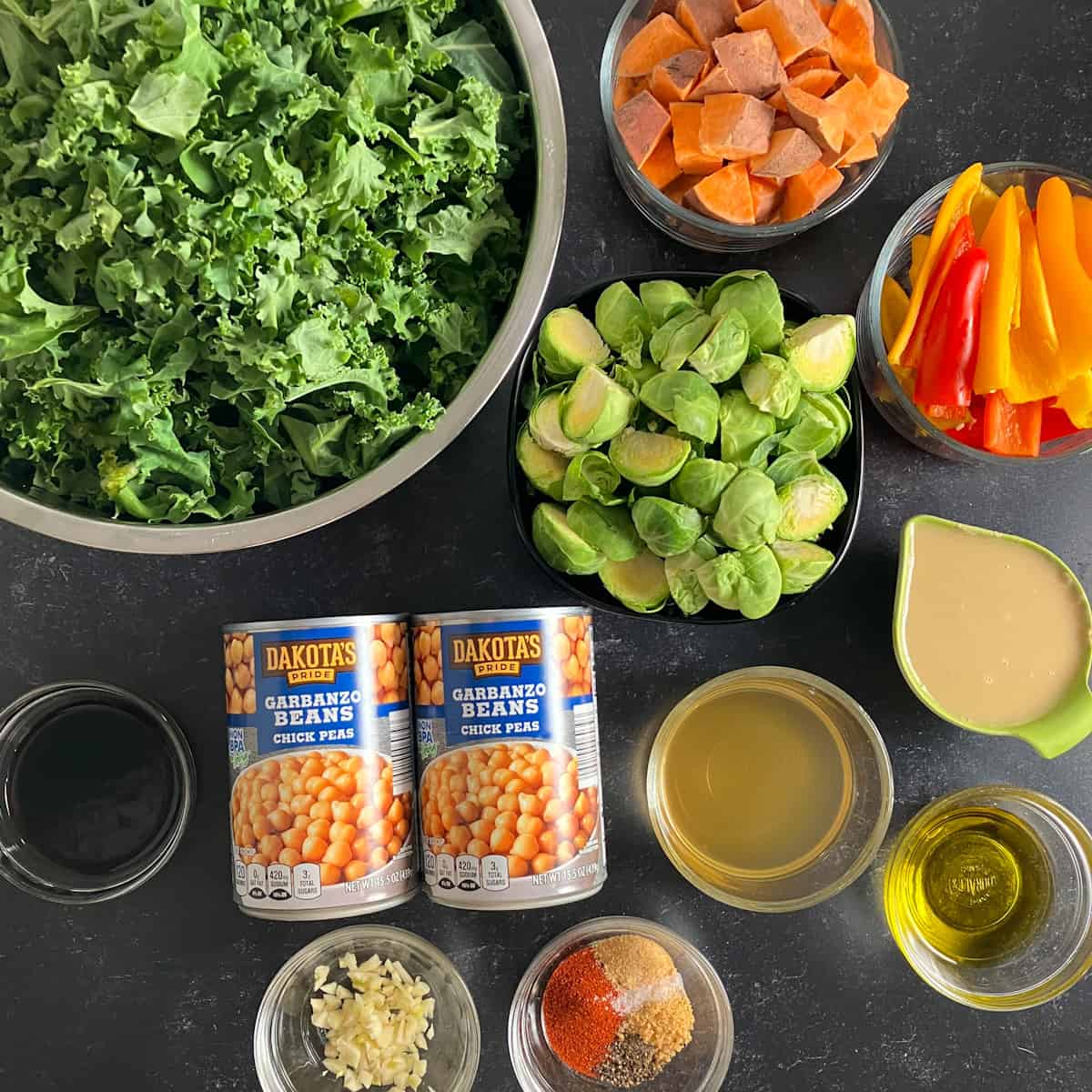
⭐ Nourish Bowl Dressing
This nourish bowl dressing is packed with plant based healthy fats. Here are the ingredients you need to make this superfood sauce:
- ¼ cup tahini
- 3 tablespoons apple cider vinegar
- 2 tablespoons reduced-sodium soy sauce
- 1-2 cloves garlic
- 1-2 tablespoons water (if needed)
To make the sauce, simply blend all of the ingredients together for 1-2 minutes in a mini food processor or blender. This dressing will thicken more as it sits.
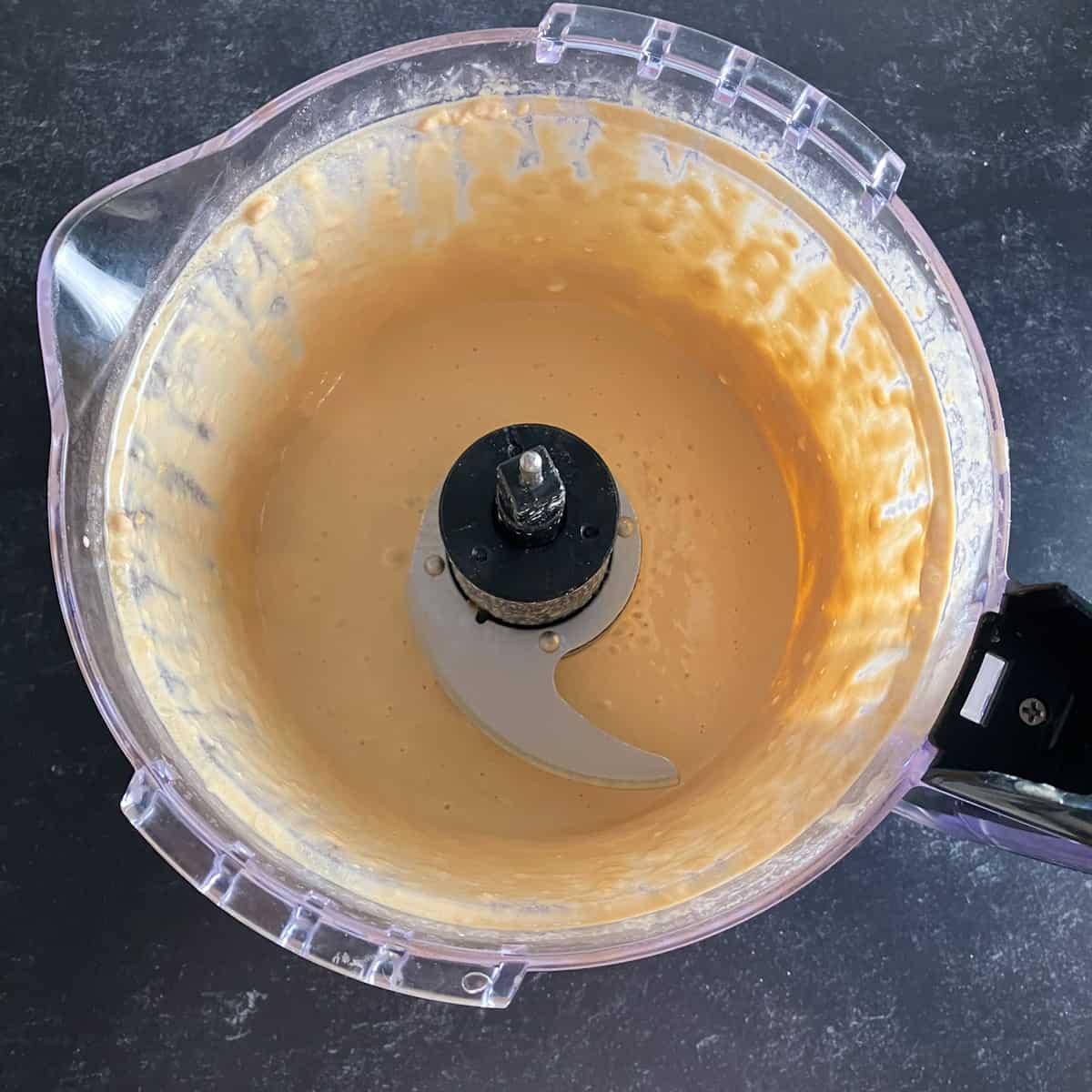
Substitute the soy sauce for coconut aminos to make gluten-free nourish bowls. You could also swap the vinegar for fresh lemon juice to make lemon tahini sauce instead. Some other nourish bowl dressing ideas include tzatziki, another yogurt sauce, green goddess dressing, keto pesto, thinned vegan chipotle mayo, BBQ sauce, salsa, guacamole, or ranch dressing.
➕ How to Make Nourish Bowls
Here are step-by-step instructions for how to make healthy bowls for weight loss:
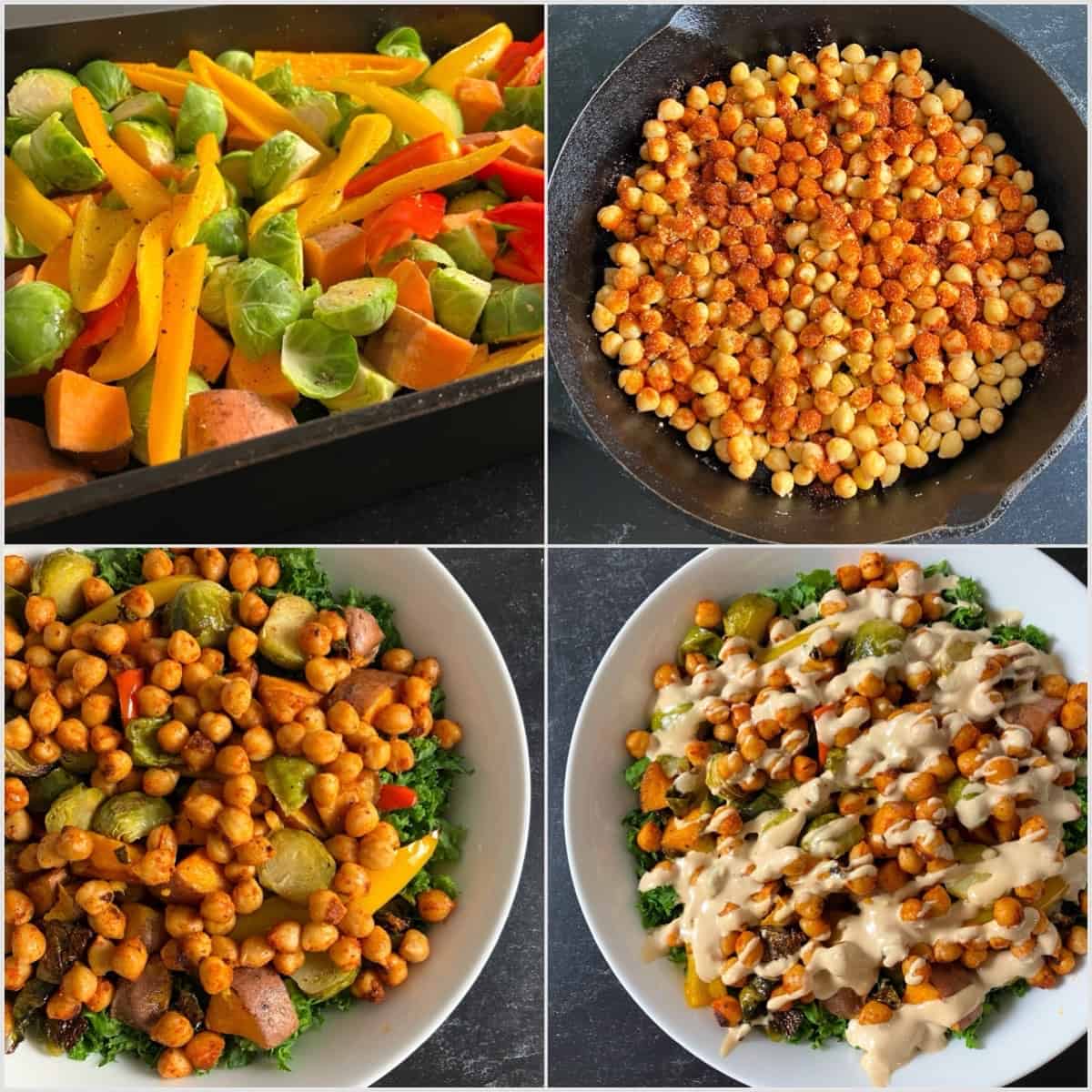
- Preheat the oven to 400F (200C) and prepare the veggies. Cut the peppers into thick slices, cube the sweet potatoes (leave the skin on for more fiber), and trim and halve the Brussels sprouts (quarter them if they’re large).
- Drizzle the veggies with oil, season with salt and pepper and roast for 45-60 minutes in a roasting pan or sheet pan about ⅓ down from the top of the oven. Flip and stir the vegetables after the first 30 minutes of cooking time.
- While the veggies cook, prepare the chickpeas. Drain two cans of chickpeas and pat them dry with paper towels. Season with smoked paprika, onion powder, garlic powder, salt, and pepper. Spray a cast iron skillet with cooking spray and warm the chickpeas in the skillet for 5-10 minutes over medium heat. Set them aside.
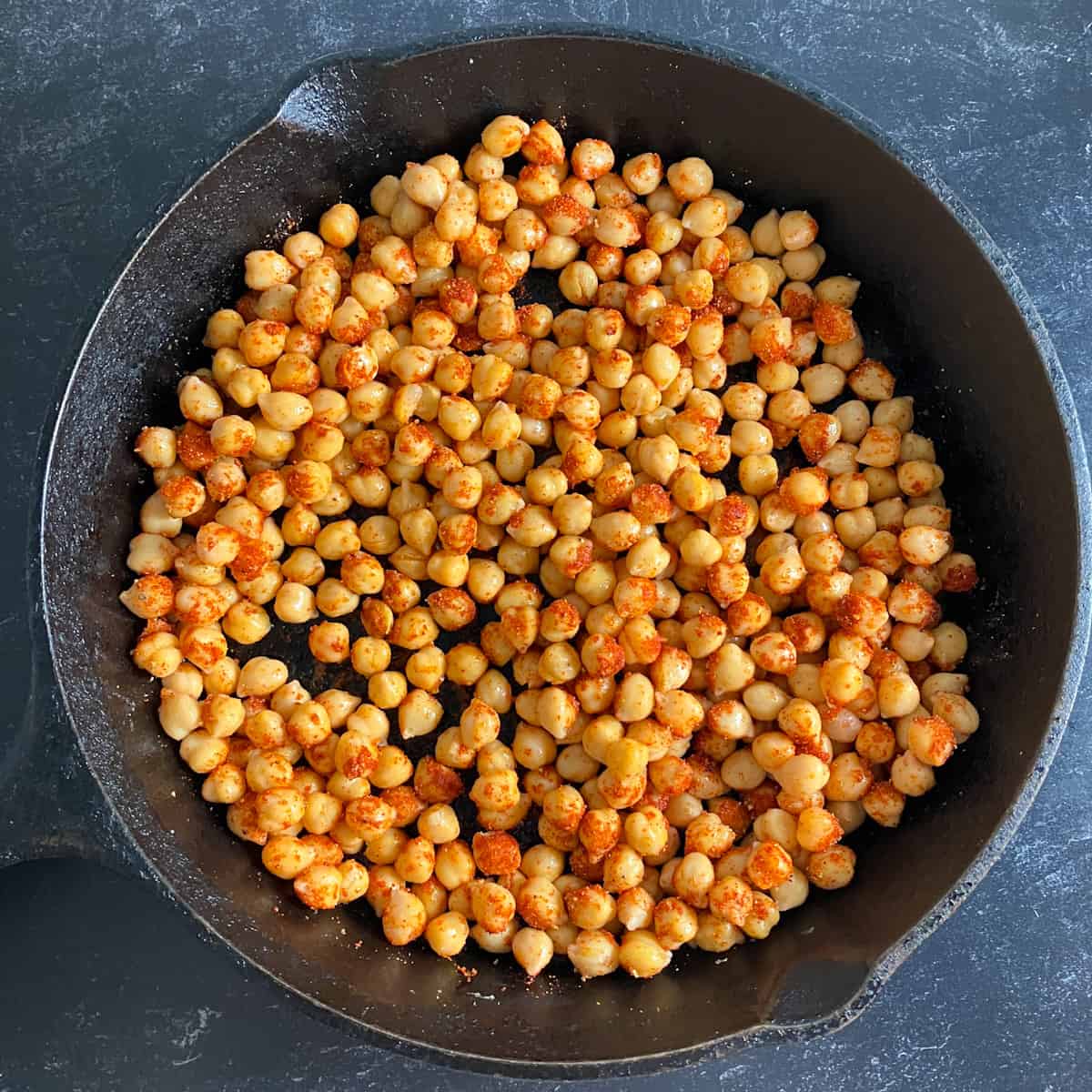
- Remove any thick stems from the kale and tear it into bite-size pieces. Massage the kale leaves in a big bowl for a few minutes with clean hands to make it tender. Set the kale aside.
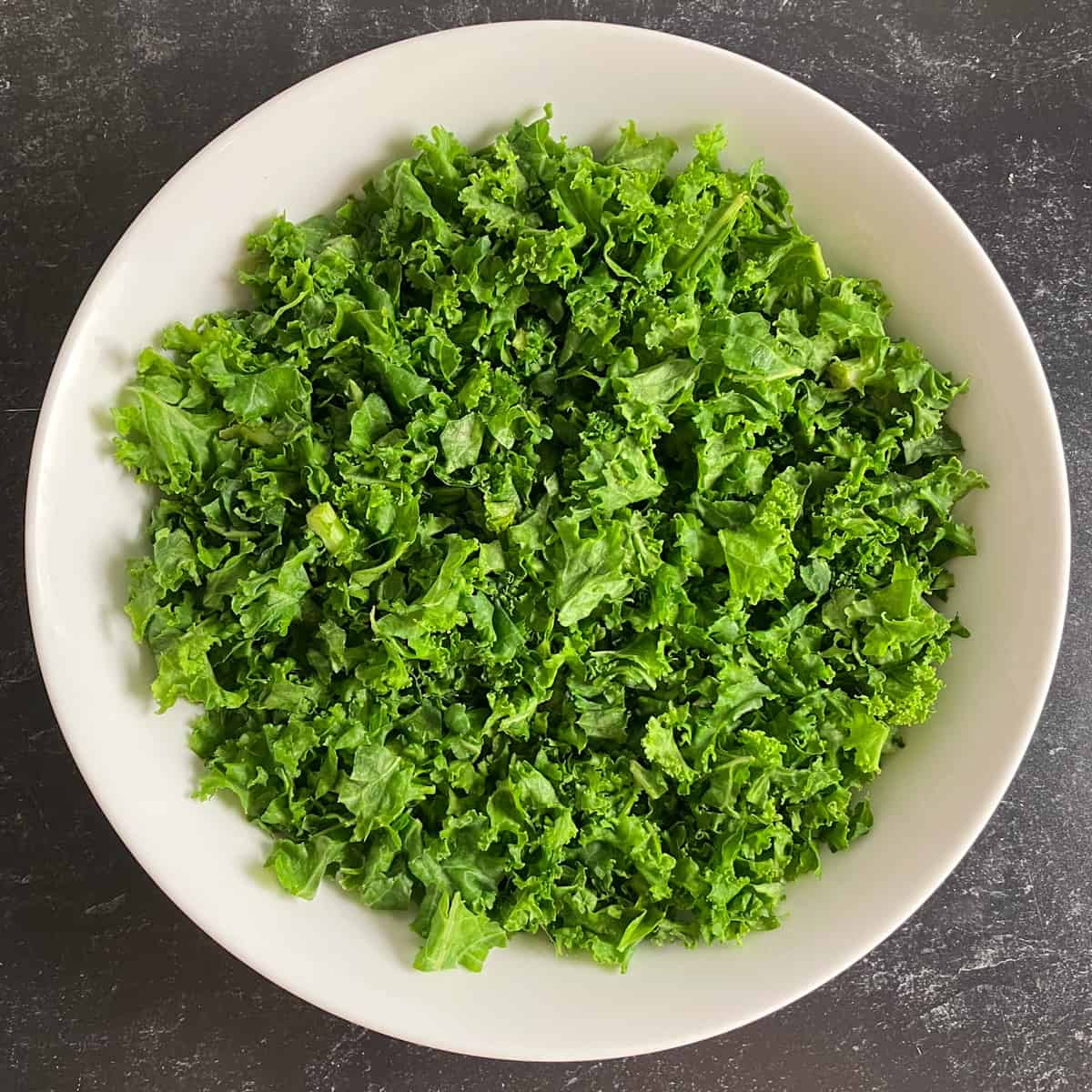
- To make the nourish bowl dressing, blend the tahini, vinegar, soy sauce, garlic, and water together.* Set it aside.
- How to assemble nourish bowls: Divide the ingredients between four bowls in this order: kale, roasted vegetables, seasoned chickpeas, dressing. Then stir everything together and enjoy!
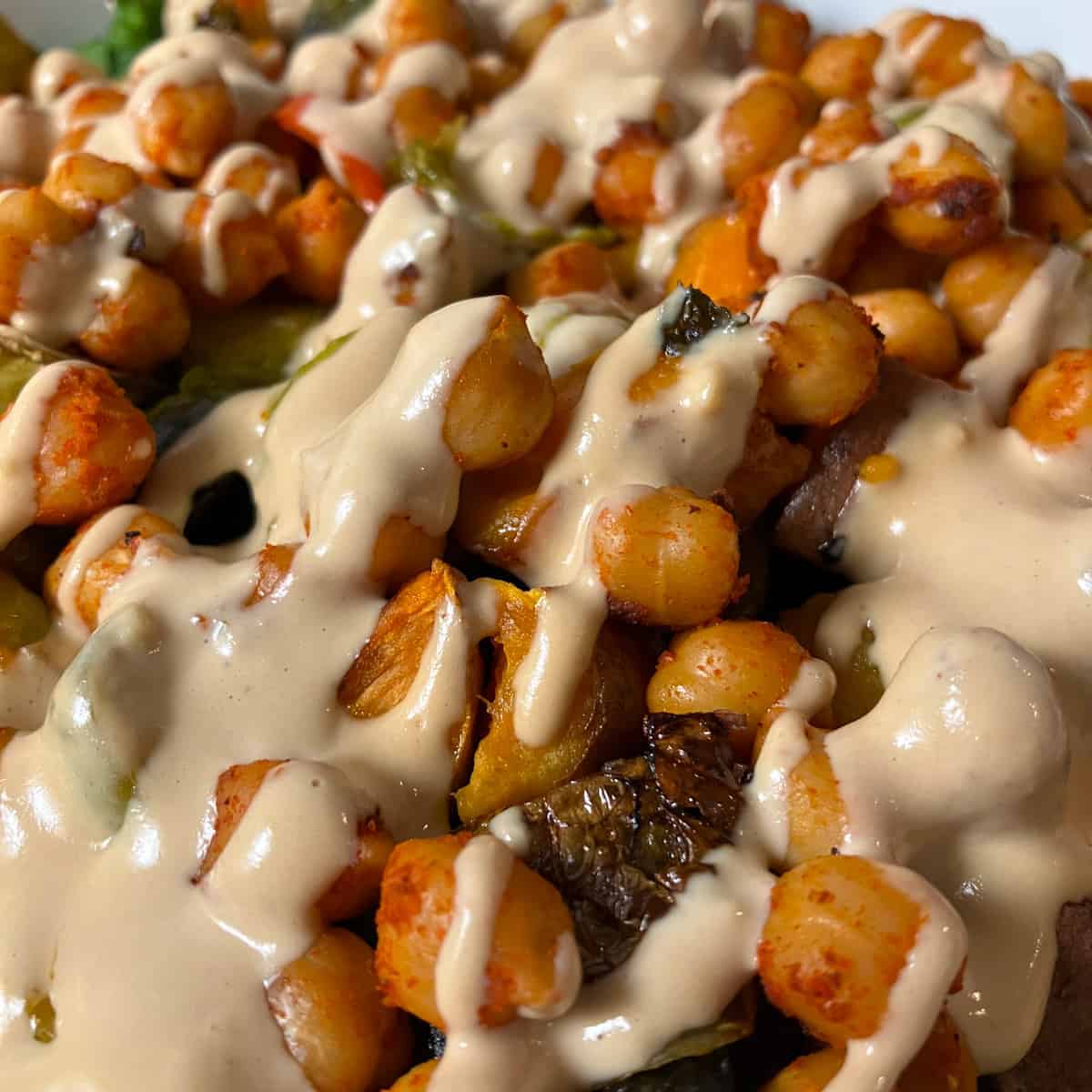
*I often double the sauce, which adds about 100 calories per serving. (It’s so good, it’s totally worth it IMVHO!)
Feel free to use other hard veggies, such as carrots and beets, in place of the sweet potatoes and Brussels sprouts. Alternatively, make a summer nourish bowl with zucchini and tomatoes, keeping in mind these soft veggies take less time to roast.
How to Store
Keep leftover nourish bowls in the fridge for up to 3-4 days in an airtight container. I recommend keeping the sauce and toppings separate until serving. Freeze any leftovers that are not consumed within 3-4 days.
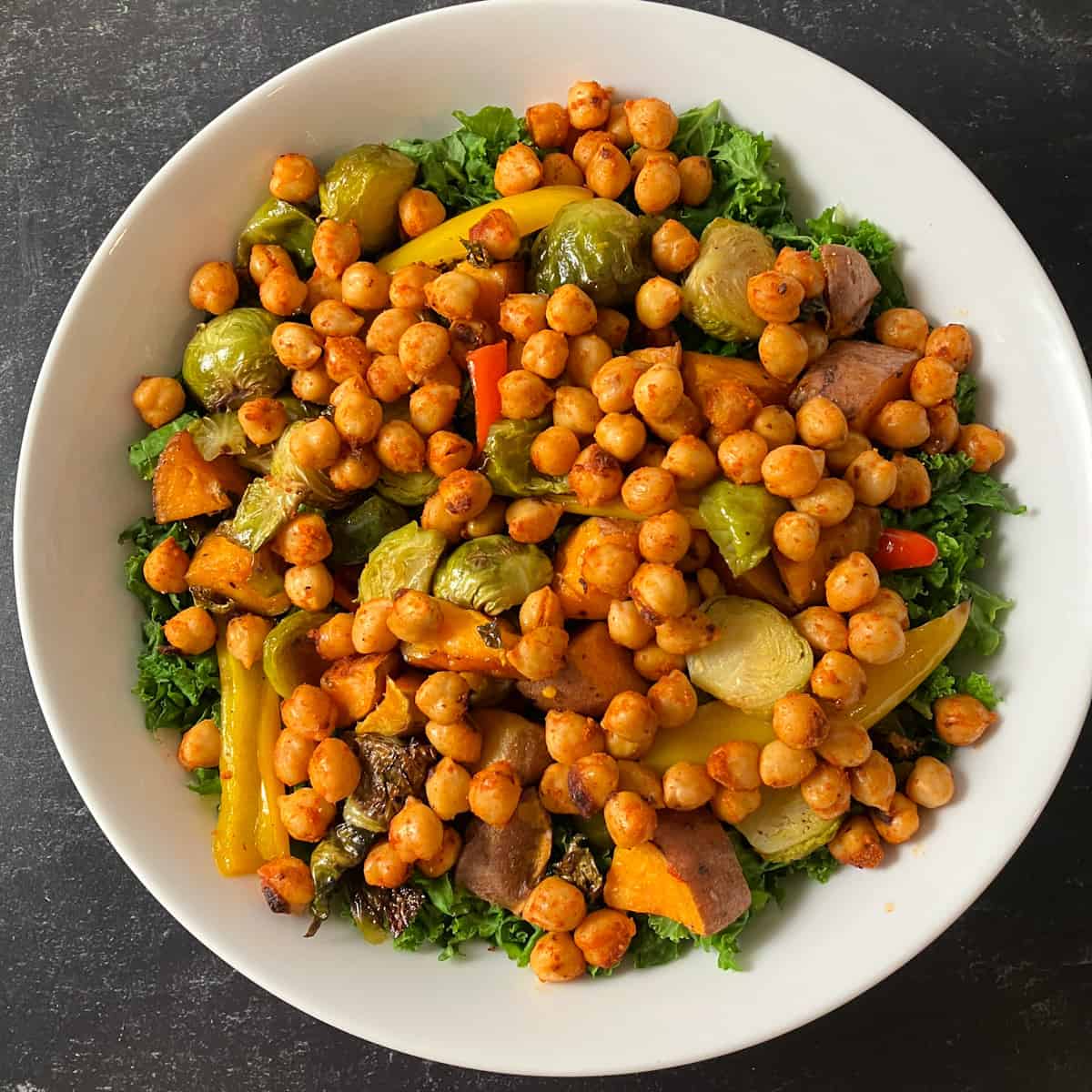
👩🍳 More Nourish Bowl Recipes
Here are some other bowl recipes packed with veggies, protein, and other nourishing ingredients that you may enjoy:
- Keto Salmon Sushi Bowl
- Inside Out Egg Roll Recipe
- Air Fryer Chicken Shawarma Bowls
- Keto Unstuffed Cabbage Rolls
- Wildflower Chopped Salad Bowl with black beans
- Canned Salmon Salad (No Mayo)
- Air Fryer Eggplant Parm (serve it on zucchini noodles or whole grain pasta to make a bowl)
- Healthy Frozen Hash Browns in Air Fryer (add eggs, avocado, cooked peppers and onions to make a breakfast nourish bowl)
If meal planning isn’t your thing, you might want to check out this comparison of Green Chef vs Hello Fresh and my review of Eat Clean to Go.
FAQs
Are nourish bowls healthy?
Yes, in terms of general nutrition, these nourish bowls are filled with healthy ingredients. You’re getting lean protein, fiber, essential vitamins and minerals, essential fatty acids, and beneficial phytonutrients here. The combination of protein, fiber, and high-volume veggies should help keep you full on fewer calories if you have a weight loss goal.
How to make nourish bowls under 400 calories?
To make this nourish bowl under 400 calories, skip the sweet potatoes, spritz the roasting veggies with cooking spray instead of drizzling with oil, and use a little less dressing. Keep in mind however that undereating nourishing foods can stall weight loss progress by leading to overeating later.
What is the difference between nourish bowls and Buddha bowls?
The terms nourish bowl and Buddha bowl are often used interchangeably to refer to a healthy veggie-packed bowl meal. Though Buddha bowls are more likely to be vegetarian than nourish bowls, you can find recipes for either with meat or seafood.
Are grain bowls good for weight loss?
Are rice bowls good for weight loss? If you’re using a low carb diet plan, grain-based bowls are typically high in carbohydrates and not a good option. On the other hand, grain bowls can be enjoyed during weight loss as long as you maintain a calorie deficit over time. I occasionally ate grain bowls with whole grains during my 70-lb permanent weight loss journey.
📖 Recipe Card
Watch How to Make It!
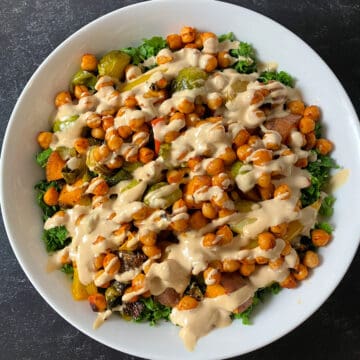
Low Calorie Nourish Bowls with Dressing (Vegetarian, Vegan)
Ingredients
- 2 medium sweet potatoes about 10 ounces or 283 grams
- 1 lb Brussels sprouts 454 grams
- 1 medium red bell pepper
- 1 medium yellow bell pepper
- 1 tablespoon olive oil
- salt and pepper, to taste
- 2 cans chickpeas, drained and rinsed (15½ ounce cans)
- cooking oil spray
- 2 teaspoons smoked paprika
- ½ teaspoon onion powder
- ½ teaspoon garlic powder
- 10 ounces kale leaves
For the nourish bowl dressing:
- ¼ cup tahini
- 3 tablespoons apple cider vinegar
- 2 tablespoons reduced sodium soy sauce
- 1-2 cloves garlic
- 1-2 tablespoons water (if needed)
Instructions
- Preheat the oven to 400°F (200°C) and prepare the veggies. Cut the peppers into thick slices, cube the sweet potatoes (leave the skin on for more fiber), and trim and halve the Brussels sprouts (quarter them if they’re large).
- Drizzle the veggies with oil, season with salt and pepper and roast for 45-60 minutes in a roasting pan or sheet pan about ⅓ down from the top of the oven. Flip and stir the vegetables after the first 30 minutes of cooking time.
- While the veggies cook, prepare the chickpeas. Drain chickpeas and pat them dry with paper towels. Season with smoked paprika, onion powder, garlic powder, salt, and pepper. Spray a cast iron skillet with cooking spray and warm the chickpeas in the skillet for 5-10 minutes over medium heat. Set them aside.
- Remove any thick stems from the kale and tear it into bite-size pieces. Massage the kale leaves in a big bowl for a few minutes with clean hands to make it tender. Set the kale aside.
- To make the nourish bowl dressing, blend the tahini, vinegar, soy sauce, garlic, and water together.* Set it aside.
- How to assemble nourish bowls: Divide the ingredients between four bowls in this order: kale, roasted vegetables, seasoned chickpeas, dressing. Then stir everything together and enjoy!
Notes
💭 Expert Tips from Dietitian Summer Yule
This is a level 1 recipe (may help support fat loss). Eating more veggies is likely a good idea for most people. According to the Dietary Guidelines in the United States, Americans on average aren't consuming vegetables at the recommended levels. This is true across all age groups. In addition, these homemade nourish bowls help you cut back on ultra-processed foods, something many of us overconsume. If you’re feeding the family, I highly recommend doubling the sauce (I usually do this). This makes the meal about 600 calories. Consider adding some grains too if you are feeding high energy eaters (such as teenagers). If you are seeking a bit more dietary balance in your life, I hope you enjoy this meal. The colorful phytonutrients are a feast for the eyes and may benefit your health if you eat your veggies often. These DIY nourish bowls are definitely something I’d consider a feel good food! Nutrition information is for one serving of the recipe.
nutrition info disclaimer
All recipes on this website may or may not be appropriate for you, depending on your medical needs and personal preferences. Consult with a registered dietitian or your physician if you need help determining the dietary pattern that may be best for you.
The nutrition information is an estimate provided as a courtesy. It will differ depending on the specific brands and ingredients that you use. Calorie information on food labels may be inaccurate, so please don't sweat the numbers too much.
"To taste" means to your preferences, which may have to be visual to follow food safety rules. Please don't eat undercooked food x
Nutrition
Join our community! Subscribe for all of the latest and greatest recipes, and follow me on Facebook, Pinterest, Instagram, and YouTube!

Hello! I'm Summer, a registered dietitian and home chef who loves to cook, eat, and create high quality content for you! Every recipe on this site has been tested by me to help ensure your success in the kitchen. All eaters are welcome here 🙂


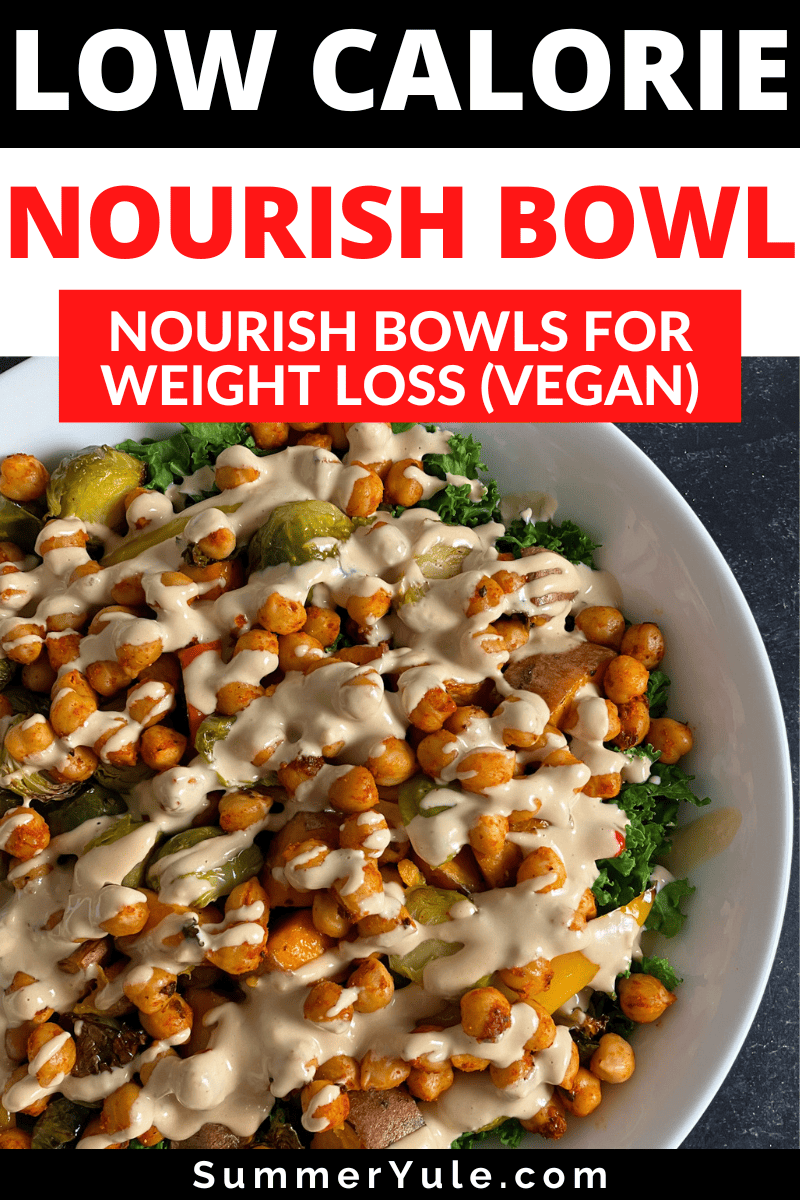
Comments
No Comments